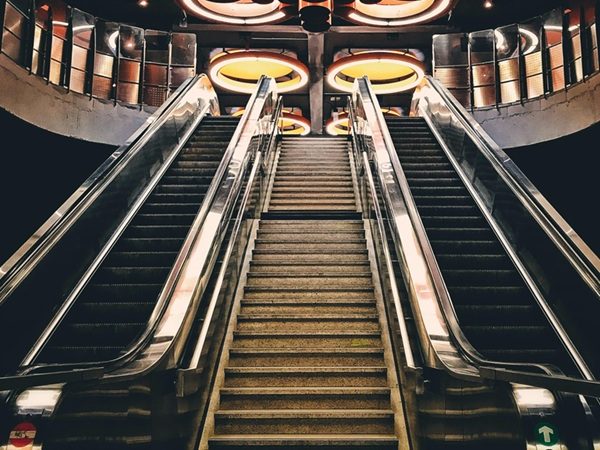The following column examines and critiques commercial design, as well as provides commentary on current issues and trends in the design industry.
The Peachtree Centre station of the Atlanta subway system is a yawning cavern blasted out of solid bedrock. Unlike the oversized drainpipes that pass for stations in Toronto, this one is Wagnerian in scale. Warehouse lighting, subdued but comfortable signing and walls of exposed rock are pleasantly garnished with piped-in baroque music.
Waiting on the platform for a short trip to the Georgia World Congress Centre is a calming experience. Upon arrival at the Congress Centre, though, the calm quickly evaporates in the updraft of the Supershow, the world’s largest annual sporting goods trade fair. With over 10,000 exhibitors spread across 2,000,000 square feet of exhibit space, this bloated circus takes on the proportions of a small city.
It is a temporary Coney Island, a place where brands become architectural and products become props in athletic sideshows. Bigger brands stand fortress-like, their walls unassailable by anyone but buyers and news hounds with the right credentials. Major contenders stage acrobatic or competitive spectacles for the amusement of passersby. Smaller players fight for attention with all manner of wobbling projectiles, impossibly buffed bimbettes and scripted demos that could pass for late night infomercials.
In this intense theatre of brand warfare, few actually stand out. Overwrought booth designs and over-scripted stage shows do more to obscure the brands than raise their profile. The Benetton Sport exhibit, suffering from too much architecture, stages a tightly-choreographed Rollerblade dance routine every hour on the hour. The Adidas exhibit is a cross between a Frank Gehry building and a highway accident. And Fila resembles a sensory deprivation chamber turned inside out, a feeble prop for its hortative tag line, ‘Change the Game’.
One understands why the smaller brands have a tougher time of it. They have to duke it out in a crowded, open arena while their big brothers can command enough space to hide their contents from the surrounding melee. With huge budgets, there should be no excuse for the biggest players to fail at building their brands. Yet most of them have spent the better part of their bankrolls on distractions that actually divert the visitor’s attention from their brands’ core values.
What this show suffers from is a paucity of ideas. Very few booths are built around a central idea or theme that flows naturally from their brand’s personality. One exception is Swiss Army Knife. Small but focused, it uses its most recognizable product – the red-handled utility knife – as a primary structural element. Display cases are flanked by columns shaped like the knives contained inside them. It is a totally integrated, 3D extension of the brand itself.
There is one big player that eclipses everyone in the show – Nike. The immensity of this brand allows it to lay claim to the most coveted real estate in the Centre. It is a 40,000-foot ballroom that is accessed by its own private escalators, thus making it a kind of indoor Mount Olympus.
Unlike its direct competitors, Nike doesn’t waste a dollar on anything that does not resonate with the brand’s core values. (It is also the only exhibit in the show with a clearly stated theme – ‘Performance’.) Many booths at this show are theatrical, but Nike is theatre – the theatre of personal mythology.
It is the only exhibit that makes a deep emotional connection with the visitor. Most others are focused on the spectacle, and treat their visitors like an audience. Nike includes them in the brand environment, invites them, through direct emotional contact, to put the brand on as if it were a second skin. This is the secret of its success.
Visitors are guided along a carefully scripted path – no variations on the traffic flow are available. You walk through a dark corridor that separates you from the outside world, cleansing your short term memory of any distracting imagery. You are suddenly confronted by two huge screens, upon which a short film introduces you to the Nike family of brands through the filter of the exhibit’s theme. The senses are overwhelmed, sound and light fully engage the emotions, and you are then invited to pass through an opening between the screens to the main showroom.
This arena of product is full of innovative exhibit design, the most captivating of which is a huge rotating drum featuring the Air line of athletic footwear. High above the viewer, the inside of the drum is covered with the full product line while a huge floor-mounted propeller sends up – you guessed it, a column of air – through the middle. Other sub-brands each have their own display areas, and the whole thing is perfectly orchestrated so that every aspect of the design and product vocabulary resonates with the closing line of the film you just saw: ‘Performance is victory’.
One emerges from this with the feeling that, on a street straddled by jerrybuilt wedding chapels festooned with rented signage, the Nike exhibit rises like a bona fide cathedral. While other brands feed you bread and circus, Nike offers deeper sustenance – a brand you can bond with.
Will Novosedlik and Bob Russell are principals of Russell Design in Toronto.























